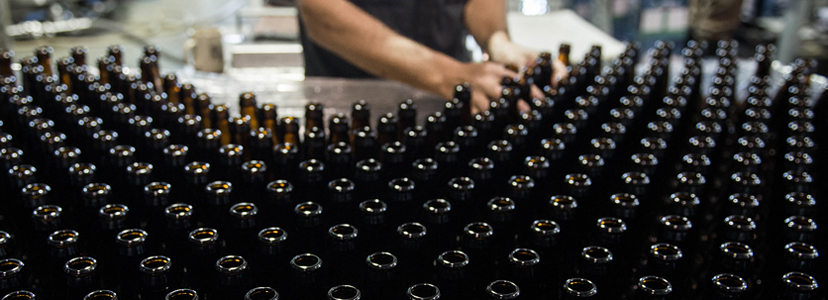Flexible or rigid packaging: what’s best for me?

When goods have been manufactured, there are several stages to be completed before they reach the end user. Packaging is crucial to the logistics process: goods have to be contained at the manufacturing stage and extra protection is required throughout storage and eventually distribution.
To deal with the sheer volume of goods that are bought online, packaging has had to adapt to meet demand. This wide range of packaging currently in use can be divided into two categories: flexible or rigid packaging. Each type has its advantages, but which is right for you?
Differentiating the two
Rigid packaging is made of material fashioned into a fixed shape. Examples include bottles, jars, cans and boxes. The materials used to make rigid packaging include glass, aluminium, cardboard and plastic.
Like rigid packaging, flexible packaging still protects the goods contained within, but its shape can change. Examples include polythene bags, pouches, and envelopes. Flexible packaging may be made of paper and metal (in the form of foil), but plastics are in wide use in this field.
Today, the manufacture of flexible packaging is steadily growing, whilst there is a gradual decline in the manufacture of rigid packaging.
Why is flexible packaging experiencing such growth?
You only have to consider the bag of sugar to realise that flexible packaging has long been in use. However, to make a cup of instant coffee with sugar, the coffee and milk would once have come from a jar and a glass bottle, whereas today, granulated coffee and milk can be purchased in pouches and plastic bottles.
Indeed, there is a strong demand for flexible packaging in the food industry. Soups, cereals and even pet food are now available in flexible packages and the trend is increasing. This is because there are advantages to using flexible packaging over rigid packaging.
Flexible packaging for example can be decorated easily. There’s no need for labels to be stuck to flexible packages because product information and brand logos can be printed directly onto them.
Virtually limitless variation is possible too. Practically any shape and size of package can be fashioned to suit any product, and it’s easy to attach handles and screw caps as well as resealable zippers and slides.
You don’t have to sacrifice protection either. Pliable plastics can be extremely tough and able to withstand tearing and puncturing. They also form an effective barrier to air, water and contaminants.
Increased flexibility: good for costs and your carbon footprint
If industry is a major driving force for the increased manufacture of flexible packaging, it is because companies have had to meet the demands of sustainability-conscious consumers, as well as needing to keep costs down by using less fuel and sending less waste to landfill (so as to avoid landfill tax).
Flexible packaging is therefore better for the environment because less material is used (and what is used is largely recyclable): the production process uses less energy.
Once the packaging is in use, its lighter weight means that more goods can be transported at once, which leads to better fuel consumption and reduced CO2 emissions. Its flexibility means that more goods can be stored in a warehouse, which is an advantage when space is at a premium.
The future: is there still a place for rigid packaging?
Rigid packaging, of course, still serves a purpose and will continue to do so. It plays an extremely important role in storage and shipping — sturdy but lightweight plastic and cardboard boxes are used extensively. Items such as books for example, will keep their shape when stored in rigid containers. It is also easy to stack rigid packages, as well as loading and unloading them, whether manually or with the assistance of pallets and a forklift truck. This is an important consideration when transshipment is involved (such as when goods are transferred from ships to lorries).
Despite the increased availability of flexible alternatives, rigid packaging has stuck around for other reasons too. Think about the plastic bottles used for bottled water: they have become increasingly lightweight to the point at which the next logical step is for them to be replaced by flexible pouches.
However, with the technology currently available, it is faster to fill bottles than pouches. This is a reminder that while making flexible packaging may be relatively inexpensive and straightforward, flexible manufacturing may be needed for its implementation.
Addressing the pouch problem requires investment in high-tech machinery. Of course, innovation will eventually result in a low-cost solution to enable faster filling, but the use of water bottles is an example of rigid manufacturing and rigid packaging working in harmony — no new technology is required so costs can be kept down.
Are you flexible about packaging?
Finally, when it comes to choosing between rigid and flexible packaging, it doesn’t have to be an either-or situation. You can use a mixture of rigid and flexible packaging to suit your needs.
Elements of flexibility can be built into rigid packages too. For example, adjustable cardboard boxes can easily be cut to the required size and designed to suit sustainability and a multitude of needs. Telescopic boxes, which are ideal for storing items such as flat screen televisions, mirrors and paintings, are a fantastic example of this.
The range of packaging options Davpack offer shows that when it comes to meeting your needs, flexibility isn’t an issue.
Remy Courtois
Latest posts by Remy Courtois (see all)
- Why Floor Marking will Improve your Business’s Safety - 15th September 2022
- Davpack’s Most Popular Eco-Friendly Products - 16th August 2022
- Reasons your Warehouse Needs Shock and Tilt Indicators - 12th July 2022
